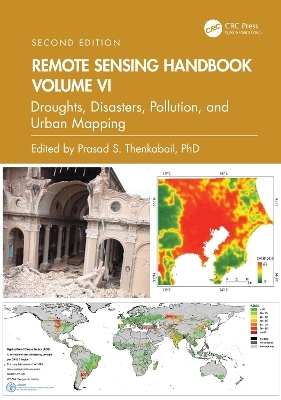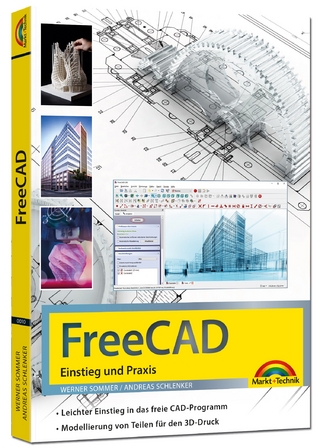
Remote Sensing Handbook, Volume VI
CRC Press (Verlag)
978-1-032-89148-4 (ISBN)
- Lieferbar (Termin unbekannt)
- Versandkostenfrei innerhalb Deutschlands
- Auch auf Rechnung
- Verfügbarkeit in der Filiale vor Ort prüfen
- Artikel merken
Volume VI of the Six Volume Remote Sensing Handbook, Second Edition, is focused on the use of remote sensing in the assessment and monitoring of droughts, dry lands, biomass burning, disasters such as volcanoes and fires, and urban studies and nightlights. It discusses land degradation assessment and monitoring, greenhouse gas (GHG) emissions, and pollution from nightlights in megacities. Chapters include remote sensing of agricultural droughts, including US drought monitoring, dryland studies, coal fires, biomass burning and GHG emissions, volcanoes, humanitarian disasters, smart cities, and night lights mapping. This thoroughly revised and updated volume draws on the expertise of a diverse array of leading international authorities in remote sensing and provides an essential resource for researchers at all levels interested in using remote sensing. It integrates discussions of remote sensing principles, data, methods, development, applications, and scientific and social context.
FEATURES
Provides the most up-to-date comprehensive coverage of remote sensing science for droughts, disasters, and GHG emissions.
Discusses and analyzes data from old and new generations of sensors.
Highlights remote sensing of agricultural droughts, humanitarian and natural disasters, and GHG emissions from coal and stubble burning.
Includes numerous case studies on advances and applications at local, regional, and global scales.
Introduces advanced methods in remote sensing, such as machine learning, cloud computing, and AI.
Highlights scientific achievements over the last decade and provides guidance for future developments.
This volume is an excellent resource for the entire remote sensing and GIS community. Academics, researchers, undergraduate and graduate students, as well as practitioners, decision makers, and policymakers, will benefit from the expertise of the professionals featured in this book and their extensive knowledge of new and emerging trends.
Dr. Prasad S. Thenkabail, Senior Scientist (ST), United States Geological Survey (USGS), is a world-recognized expert in remote sensing science with major contributions in the field for nearly 40 years. He has made the list of the world’s top 1% of scientists across 22 scientific fields and 176 sub-fields. Dr. Thenkabail has conducted pioneering research in hyperspectral remote sensing of vegetation, global croplands, and their water use for food security. He obtained his PhD from the Ohio State University in 1992 and has 168 peer-reviewed publications including 15 books, including this six-volume set, and over 15 major data releases such as the Landsat-derived global cropland extent product @ 30m and Landsat-derived rainfed and irrigated cropland area product @ 30 m (LGRIP30). He was recognized as a Fellow of the American Society of Photogrammetry and Remote Sensing (ASPRS) in 2023. His scientific papers have won several awards for demonstrating world-class, highest-quality research. He was a Landsat Science Team Member (2007-2011).
Part I: Droughts and Drylands. 1. Drought Monitoring Using Vegetation Health Indices. 2. Studies using Space-derived Vegetation and Biophysical Products: A Global Perspective. 3. Remote Sensing of Drought: Satellite-Based Monitoring Tools for the United States. 4. Regional Drought Monitoring Based on Multi-Sensor Remote Sensing. 5. Land Degradation Assessment and Monitoring of Drylands. Part II: Disasters. 6. Disasters: Risk Assessment, Management and Post-Disaster Studies Using Remote Sensing. 7. Humanitarian Emergencies: Causes, Traits and Impacts as Observed by Remote Sensing. Part III: Volcanoes. 8. Remote Sensing of Volcanoes. Part IV: Fires. 9. Satellite-derived Nitrogen Dioxide Variations from Biomass Burning in a Subtropical Evergreen Forest, Northeast India. 10. Remote Sensing-Based Mapping and Monitoring of Coal Fires. Part V: Urban. 11. Urban Growth and Climatic Mapping of Mega Cities: Multi-Sensor Approach. 12. High-Resolution Remote Sensing and Visibility Analysis Method for Smart Environment Design. Part VI: Nightlights. 13. Nighttime Light Remote Sensing -- Monitoring Human Societies from Outer Space. Part VII: Summary and Synthesis for Volume VI. 14. Remote Sensing Handbook, Volume VI: Droughts, Disasters, Pollution, and Urban Mapping.
| Erscheinungsdatum | 07.11.2024 |
|---|---|
| Reihe/Serie | Remote Sensing Handbook |
| Zusatzinfo | 42 Tables, black and white; 105 Line drawings, color; 11 Line drawings, black and white; 43 Halftones, color; 7 Halftones, black and white; 148 Illustrations, color; 18 Illustrations, black and white |
| Verlagsort | London |
| Sprache | englisch |
| Maße | 178 x 254 mm |
| Gewicht | 1100 g |
| Themenwelt | Informatik ► Grafik / Design ► Digitale Bildverarbeitung |
| Naturwissenschaften ► Geowissenschaften ► Geografie / Kartografie | |
| Naturwissenschaften ► Geowissenschaften ► Geologie | |
| Technik ► Elektrotechnik / Energietechnik | |
| Technik ► Umwelttechnik / Biotechnologie | |
| ISBN-10 | 1-032-89148-3 / 1032891483 |
| ISBN-13 | 978-1-032-89148-4 / 9781032891484 |
| Zustand | Neuware |
| Informationen gemäß Produktsicherheitsverordnung (GPSR) | |
| Haben Sie eine Frage zum Produkt? |
aus dem Bereich


